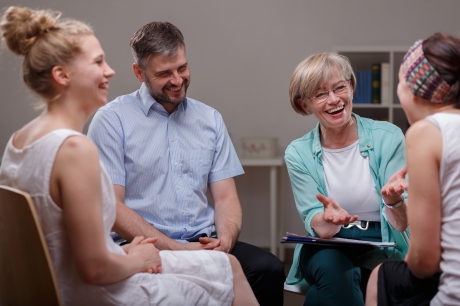
Sunday, some age 9-12 neighbor kids ganged together and rejected a bigger, awkward tween boy. While walking Miss Wendy, we witnessed his agony and rage at their behavior as they screamed and ran away, hurling insults at the kid, locking themselves in family SUV, sticking their tongues out, shouting, ‘Nah, nah, nah, nah, big goofball’ –and other, shocking language, their parents would have surely censored. The dog was visibly upset. It prompted a lot of memories from childhood, and thinking about a big topic: rejection.
‘LuAnn’ has a history of getting angry at people and cutting them off. Out-right rejection. This might be considered an immature way of dealing with interpersonal conflict, which resulted in escalating anger directed back towards her and her family. The ‘rejected’ count included an older sibling, a sister-in-law, an uncle, various friends, additional kin, and even a child for a year or two. Rejection is a form of emotional blackmail or emotional abuse. One always wonders what led to this response; what made this the ‘go to’ way of dealing with disagreement. The behavior is often exhibited in families, when it has become systemic. LuAnn’s daughter behaves in exactly the same way, but fails to see it in herself, and won’t discuss it. There are times when it is in a person’s best interest to step back from a relationship, a self-protective, last choice, when abuse or emotional trauma are too much to bear. After ‘Wayne’, an addict had stolen from nearly everyone he knew, no one wanted to see him again. He died alone, of an overdose, far from home, rejected by everyone, who had tried everything.
‘Todd’ was in a relationship with male partner for several years, completely estranged from the family who condemned his orientation and choice. The rejection hurt especially bad coming from those who had professed to love him (but only on their terms), that he required extensive therapy. The media has featured many stories of teens feeling suicidal from the sting of rejection for expressing an alternative gender orientation.
Rejection can take many forms. Sometimes it manifests as angry outbursts from deep-seated emotional pain against the person or persons who caused it, or anyone who represents/reminds one of that person. A person might harbor simmering hostility towards the abusive partner of a parent, and subsequently anyone who triggered that rage, unwittingly or not. Untreated, it can become toxic. Trauma can be involved on both sides of a seriously disrupted relationship. But it’s not hopeless. In the Home Alone Christmas movie, the elderly man’s relationship is restored with his children, and healing takes place. The Prodigal Son is a well-known theme from ancient times, where the son returns to his father, apologizes and begs acceptance. That’s probably the exception rather than the rule; a standard for all time.
For ‘Lynette’, rejection moved to a symbolic form of revenge, cutting her ex-husband’s photos out of family pictures. Her transition age son shrugged and shook his head. ‘He’s still my dad,’ the teen said, with an odd look on his face. It was no accident he’d downloaded and listened to an old school (’89) rock song recently by Don Henley, ‘The Heart of the Matter’ [https://www.youtube.com/watch?v=Xezg3z5IE8I] Knowing there would be holidays, graduation, wedding, and probably grand-children in the future made him sad, just thinking about what used to be and was to come. Rejection is a complex topic. There are ideas how to deal with differing aspects of rejection.
Read more here:
http://ideas.ted.com/why-rejection-hurts-so-much-and-what-to-do-about-it/
http://www.patheos.com/blogs/freedhearts/2015/11/10/to-reject-ones-child-is-the-worst-transgression/
https://www.psychologytoday.com/blog/the-squeaky-wheel/201307/10-surprising-facts-about-rejection
http://www.wikihow.com/Handle-Rejection
http://www.apa.org/monitor/2012/04/rejection.aspx
http://kidshealth.org/en/teens/rejection.html
Check out the Lyrics: http://www.azlyrics.com/lyrics/donhenley/theheartofthematter.html


 By embedding the Maryhaven program within Pomegranate’s multi-disciplinary treatment approach, it functions alongside Pomegranate’s clinical and medical therapies to offer a more comprehensive treatment for those requiring AOD counseling, or identified with substance use disorder issues. Its important to identify and treat or teach the tools to recover.
By embedding the Maryhaven program within Pomegranate’s multi-disciplinary treatment approach, it functions alongside Pomegranate’s clinical and medical therapies to offer a more comprehensive treatment for those requiring AOD counseling, or identified with substance use disorder issues. Its important to identify and treat or teach the tools to recover. At the NASW National Association of Social Work Conference-Ohio Chapter last week, dozens of workshops were offered. Often, in an emergency situation such as occurs at a busy hospital ED, you’re dealing with more than the patient and must consider the entire family. Therapists Marilyn Gale LISW-S and Julie Sheehan LSW, MSW developed their workshop presentation ‘Family Therapy Meets Crisis Intervention’ based upon years of experience through Cincinnati Children’s psych ED and PIRC-psychiatric intake response center. This includes intake calls, the physical ED environment and ED physicians, telemedicine-interview through an I-pad if off site, and having a crisis presence. It involves family therapy from a systems theory perspective.
At the NASW National Association of Social Work Conference-Ohio Chapter last week, dozens of workshops were offered. Often, in an emergency situation such as occurs at a busy hospital ED, you’re dealing with more than the patient and must consider the entire family. Therapists Marilyn Gale LISW-S and Julie Sheehan LSW, MSW developed their workshop presentation ‘Family Therapy Meets Crisis Intervention’ based upon years of experience through Cincinnati Children’s psych ED and PIRC-psychiatric intake response center. This includes intake calls, the physical ED environment and ED physicians, telemedicine-interview through an I-pad if off site, and having a crisis presence. It involves family therapy from a systems theory perspective.






